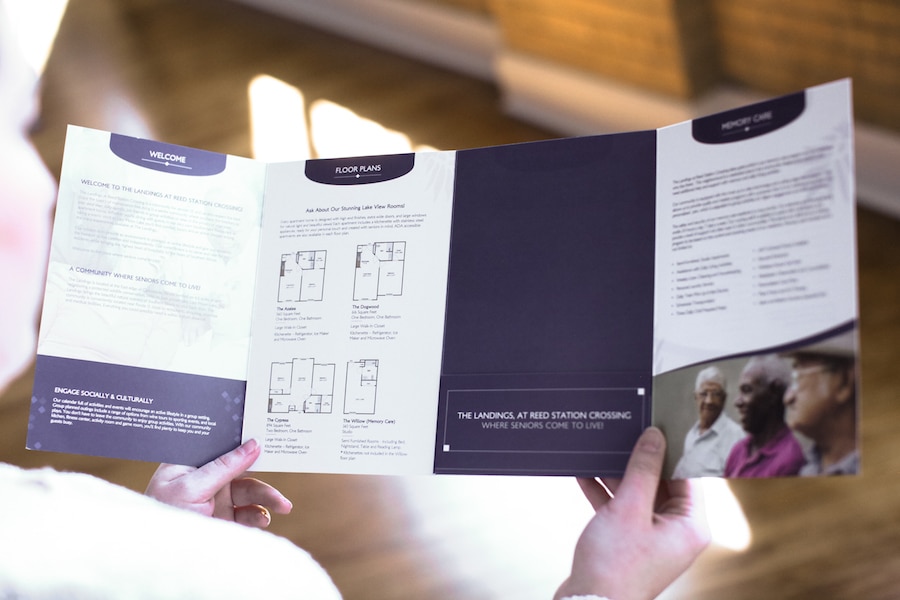Best Practices for Creating Effective Print Marketing Collateral

We often speak about the four channels of digital marketing and how they work in tandem to nurture prospects into clients for your business. With so much emphasis on digital marketing, you may wonder if print marketing collateral is still an effective marketing tool for your business. The answer is yes when those pieces are created properly. Follow these tips to get the most out of your print marketing investment.
Common Uses of Print Marketing
Postcard mailers, rack cards, and billboards are effective means to introduce your brand to new prospects. Once you’ve connected with a potential customer, brochures, tri-folds, and informational flyers can be used to share additional information about your company and the problems you solve.
If you regularly exhibit at tradeshows, present at conferences, or conduct 1:1 sales meetings, having print collateral to leave behind with your audience can serve as a physical reminder of your company and the information you have just shared.
Regardless of what you create, you must be diligent in creating your print marketing collateral. Start by identifying its purpose: are you introducing your company to a stranger? Are you providing additional information about your services to someone already familiar with your brand? Is your prospect at the nurturing stage of your sales funnel or are they close to making a purchase decision? Your answers to these questions determine what type of print collateral you develop and what information should be contained in the document.
If the purpose of your document is to connect with someone unfamiliar with your brand, a postcard mailer or introductory flyer may be useful in attracting attention to your brand, product, or service. If the purpose of your document is to share additional information with a prospect who has already shown an interest in your company, a trifold brochure or informational flyer can be useful in providing information that builds trust and nurtures the sale.
Content to Include in a Print Marketing Piece
The most important thing to remember when creating digital and print marketing documents is this: It’s not about you – it’s about your client.
One of the biggest mistakes a company makes to decrease the effectiveness of its print marketing materials is cramming too much information on the document without a clear takeaway. When consumers shop for products or services, they are trying to satisfy personal needs. If you make it too difficult for a prospect to quickly identify what you do and what benefits you provide or problems you solve, they will not read your content or connect with your brand.
Materials like postcards and introductory fliers should be designed with large visual images that draw the eye and convey your message’s feelings. Written copy should be restricted to the fewest number of words needed to grab the reader’s attention and makes them want to know more. Your message should be about the benefit you provide, the problem you solve, or a statement that makes the reader say, “tell me more.” A strong call to action leads the prospect to the next step. This call to action might be a link to a landing page on your website or a phone number to call for more information.
Informational materials should be used further down the sales funnel. These documents can contain more written content; however, you must still aim to be succinct. Use headers to help your readers identify the most important information on the document. Keep the material visually interesting by incorporating relevant photos and images. Avoid large blocks of text to make your content easy to digest. Just like introductory materials, your informational print materials should have a very clear call to action that prompts your prospect to take the next step.
Tips for Crafting a Strong Call to Action
Your call to action will vary depending on your business type. Retail businesses generally have a shorter sales cycle therefore transactional calls-to-action are appropriate.
Example transactional call-to-actions:
- Buy Now!
- Save 50% During Our New Year’s Sale, now through 1/15/23
- Get Free Shipping in January!
- View Our Inventory Online
Professional services firms and high-end retail products require a longer sales cycle that requires more research and likely conversations with sales staff before a prospect is ready to be a paying client. This makes transactional calls-to-action like “Buy now” inappropriate. In this case, your best call to action is to prompt the prospect to learn more.
Example call-to-actions for longer sales cycles:
- Call us to schedule a free consultation
- Visit our website to get a free trial of our software
- RSVP on our website to attend our event
- Email us to schedule a product demonstration
Your call-to-action communicates to the prospect what step they take next. Make sure this is crystal clear and impossible to miss on your materials.
Remember — at the end of the day, you need to make it as easy as possible for your reader to decide if they’re interested in what you have to say. When you create your collateral with the tips above in mind, you’ll be more likely to convince them to act thus improving your likelihood of landing a relationship with a new client.
